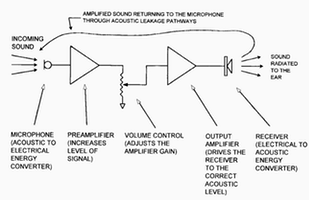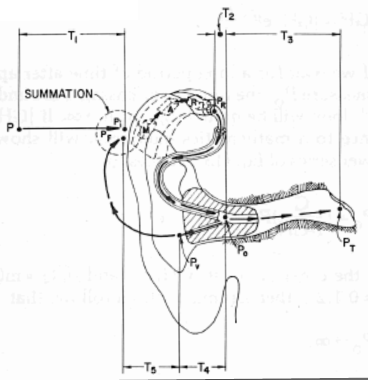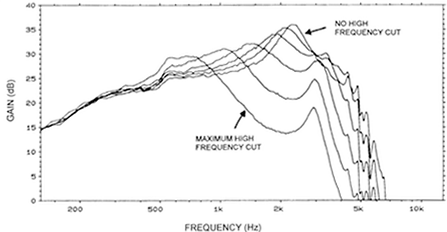Acoustic feedback is well-known and continues to be a major concern for those wearing hearing aids. This is caused by the leakage of sound from the hearing aid speaker (receiver) back to the microphone (Figure 1). This sound wave leakage from the output back to the input produces a form of instability, resulting in an audible oscillation.

Figure 1. Airborne pathway from a hearing aid leading to acoustic feedback (Agnew, 1996).
In essence, amplified sound is returned to the microphone and this open loop circle of sound transmission is continuously amplified to the point at which a tonal squeal occurs. This is an undesired acoustic coupling between the hearing aid speaker and the microphone. The consequence of acoustic feedback is to limit the maximum amplification that can be used in the hearing aid without making it unstable. This level is often referred to as maximum stable gain (MSG). MSG has also been referred to in the literature as Actual Feedback Limit, maximum feedback-free gain, maximum available gain, critical gain, or open loop gain (OLG), and probably in other ways as well. Perhaps OLG should not be used because it is defined as a specific technique to measure the MSG.
The amount of leakage leading to acoustic feedback can result from many factors, including: 1) type of hearing aid, 2) amount of slit leakage around the earmold, 3) venting and type, 4) residual ear canal volume, 5) length and diameter of the canal area where the shell fits, 6) pinna size and shape, 7) fit of the aid in the ear canal, 8) frequency response and gain of the hearing aid, 9) gain control setting, 9) hearing aid output, 10) eardrum impedance, 11) orientation of the hearing aid sound bore in the ear canal, and most likely other issues as well. All influence whether feedback will occur and at what frequency. Figure 2 illustrates the effects of leakage in a typical hearing aid application, with the acoustic feedback path in black arrows from the vent pressure leakage (Pv), back to the input microphone (M) where the feedback pressure (Pf) is summed with the normal microphone input pressure (Pi), then through the amplifier (A), to the receiver (R), down to the earmold – and then all over again. This illustrates an open feedback path.

Figure 2. Feedback loop as applied to a hearing aid (Egolf, 1982).
Frequency of Acoustic Feedback
Acoustic feedback typically occurs at or near the high frequency peaks in the hearing aid frequency response because they occur at the frequency of the greatest gain. These peaks are a result primarily of hearing aid speaker resonances, which have an effect on the acoustic output of the hearing aid. The peaks vary with the dimensions of the specific speaker model used and are especially influenced by the mechanical case size. Although acoustic feedback tends to occur at a single primary frequency, audible multiples (harmonics) occur due to saturation of the amplifier. Feedback typically occurs between 2000 and 5000 Hz and is often initiated by high-frequency gain of the hearing aid that is used to provide more amplification in the high rather than low frequencies to satisfy the hearing loss. Additionally, the higher the hearing aid use gain, the more likely feedback will occur.
Acoustic feedback is not always an “all or none” phenomenon. In reality, it works through several stages depending on the in-situ moment and ambient sound environment. Patients often comment about an experience of sub-oscillatory feedback, which is just below the point of continuous audible oscillation. When the hearing aid is in this condition, transient loud sounds often initiate the sensation of random ringing. This is the result of variable and/or intermittent stimulation of the hearing aid in and out of feedback by sounds having high energy at the feedback frequency. In order to clinically identify this type of feedback and confirm the patient complaint, the headphone provided with a probe-mic system can be used. This allows the fitter to simultaneously experience the patient complaint. If reducing the gain slightly eliminates this sub-oscillatory feedback, it indicates a highly unstable state that is likely to progress rapidly into sustained audible oscillations.
Acoustic Feedback Solutions
Knowing the causes of acoustic feedback allows for an understanding of the direction that solutions to solving it have taken. While there are a number of acoustic approaches that can be taken (remake the earmold, reduce the size of the vent, use in-line filters to smooth the peaks or overall response, etc.), this blog will focus on electronic methods, and will attempt to present them in the order in which they have occurred – often dictated by the electronics of the day.
Acoustic Feedback Solution #1 – Overall Gain Reduction
Because acoustic feedback is caused by a combination of excessive gain and phase angle at a critical frequency, a logical approach is to reduce the gain until feedback ceases (using the volume control wheel). This was most likely one of the first approaches used with hearing aids. The problem with this approach is that the reduced gain may no longer be sufficient for the patient. Or, if using the hand over the ear as a determination of feedback to employ gain reduction, the result my leave the hearing aid in a sub-oscillatory feedback state. As a result, intense sounds may drive the hearing aid in and out of oscillation.
Acoustic Feedback Solution #2 – Reduction of High-Frequency Gain
Because acoustic feedback is typically associated with high frequencies, an approach that has been used is to reduce the gain in the high frequencies. In the past this was accomplished mainly with the use of a low-pass potentiometer (reduce the highs) or by asking the manufacturer to reduce the high frequency gain. Unfortunately, an excessive amount of high-frequency gain may have to be reduced to eliminate feedback that the aid then fails to meet the basic amplification needs of the patient. The irony of this is that high-frequency gain was most likely requested (formula to fit the loss, or mirroring – not really any significant difference between the two in terms of recommending high- frequency amplification) so that high frequencies could contribute to intelligibility, and then they are taken out, with a known reduction of intelligibility. This method often results in a teepee-shaped hearing aid response. I find it amazing how many teepee-shaped hearing aid responses I see suggesting that this approach continues to be used to reduce feedback. Figure 3 shows graphically the change from a fairly broad frequency response to amplification in the 500 to 1000 Hz region as more and more high frequencies are eliminated from the hearing aid. The latter stages are what I have termed the teepee-type hearing aid response.

Figue 3. Six superimposed frequency response curves showing the progressive effects of a high frequency cut potentiometer on the response of a typical hearing aid (Agnew, 1996).
Next blog – Continuing with a time-line of methods employed to reduce acoustic feedback in hearing aids.
References
Agnew, J. Acoustic feedback and other audible artifacts in hearing aids. Trends in Amplification, Vol. 1, No. 2, 1996, pages 56 and 72.
Egolf, D. Review of the acoustic feedback literature from a control system point of view. The Vanderbilt Hearing-Aid Report: State of the Art – Research Needs. Studebaker, G, and Bess F. (Eds.). Monographs in Contemporary Audiology, Upper Darby, PA, pp.94-103.
Wayne Staab, PhD, is an internationally recognized authority in hearing aids. As President of Dr. Wayne J. Staab and Associates, he is engaged in consulting, research, development, manufacturing, education, and marketing projects related to hearing. His professional career has included University teaching, hearing clinic work, hearing aid company management and sales, and extensive work with engineering in developing and bringing new technology and products to the discipline of hearing. This varied background allows him to couple manufacturing and business with the science of acoustics to bring innovative developments and insights to our discipline. Dr. Staab has authored numerous books, chapters, and articles related to hearing aids and their fitting, and is an internationally-requested presenter. He is a past President and past Executive Director of the American Auditory Society and a retired Fellow of the International Collegium of Rehabilitative Audiology.
**this piece has been updated for clarity. It originally published on April 8, 2012







Thanks for this, Wayne. I always had a great deal of acoustic feedback, but my latest ITC hearing aids have ‘locks’ on them, causing very little feedback. In fact, the only time I really experience feedback is when I’m doing morning makeup and my head is tilted slightly back as I look in the mirror. (If you were ever to put on mascara, you would understand better the neck movement of which I speak!).
Gael